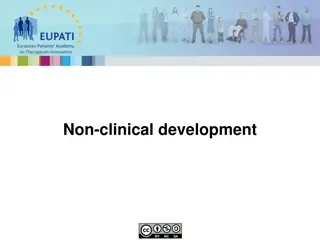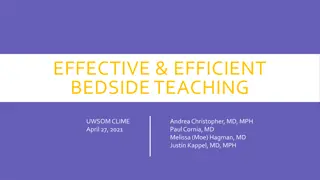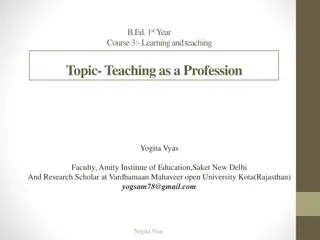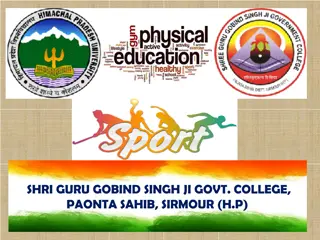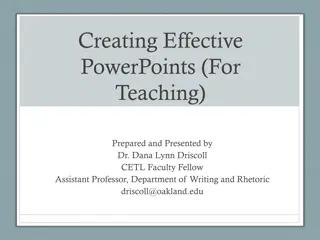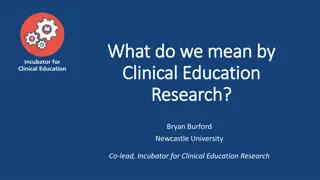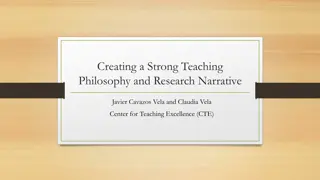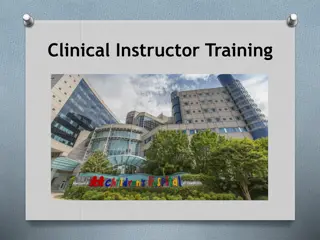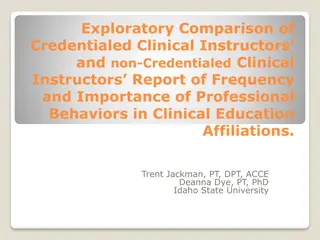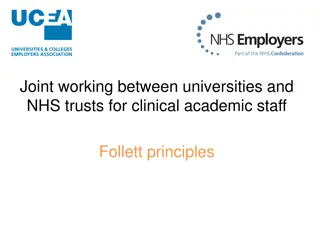Principles and Strategies for Effective Bedside Teaching in Clinical Settings
Explore the key concepts of bedside teaching in clinical rounds, focusing on patient-centered education, principles of adult learning, and strategies for effective teaching. Learn about the importance of clear objectives, active involvement, and feedback in the teaching process. Discover where bedside teaching can take place and common challenges faced in clinical education.
Download Presentation

Please find below an Image/Link to download the presentation.
The content on the website is provided AS IS for your information and personal use only. It may not be sold, licensed, or shared on other websites without obtaining consent from the author.If you encounter any issues during the download, it is possible that the publisher has removed the file from their server.
You are allowed to download the files provided on this website for personal or commercial use, subject to the condition that they are used lawfully. All files are the property of their respective owners.
The content on the website is provided AS IS for your information and personal use only. It may not be sold, licensed, or shared on other websites without obtaining consent from the author.
E N D
Presentation Transcript
Dr.E.Ananda Reddy, Professor & Head, Department of Psychiatry, N.M.C.H
Meaning of word Doctor. What is difference between Disease vs illness. Andragogy & Heutagogy. CBME One minute preceptor.
Scheme of presentation. General Principles. Strategies for teaching during clinical rounds. Preparation including patient selection before teaching bedside clinics. Structure for bedside teaching (Briefing Practice-Debriefing). Strategies of Examination (Skill) practice at the bedside.
Principles of adult learning Adults: Have a specific purpose in mind; Are voluntary participants in learning; Require meaning and relevance; Require active involvement in learning; Need clear goals and objectives; Need feedback; Need to be reflective.
A bedside teaching is a process in which a clinical teacher and a group of learners sees a patient, elicits or verifies physical signs, discusses provisional diagnosis, diagnostic or therapeutic options in the clinical setting. -GABERSON. -
Where bed side teaching done? Hospital. Long-term care facility. Out patient Office/clinical setting. Community.
Patient-Centered Teaching Patient-centered teaching = Teaching what needs to be taught, for sake of patient vs. Teacher-centered teaching = Teaching what one knows, even if it does not address the patient s problems Treating the disease vs. treating the illness effective teachers do not prioritize disease (what the patient has), but instead illness (what the patient feels)
Problems with clinical teaching Lack of clear objectives and expectations. Focus on recall of facts rather than problem solving. Lack of active participation by learners. Inadequate direct observation of learners and feedback. Insufficient time for reflection and discussion. Lack of congruence with the rest of the curriculum.
Solutions for the problems Stanford faculty development model. One-minute preceptor model. SNAPPS model.
Stanford Faculty Development model (1) Promoting a positive learning climate. (2) Control of session. (3) Communication of goals. (4) Promoting understanding and retention. (5) Evaluation. (6) Feedback. (7) Promoting self-directed learning.
The one-minute preceptor(OMP) The Micro skills of teaching, uses a five-step approach. Step 1. Getting a commitment: Step 2. Probing for supporting evidence: Step 3. Teaching general rules: Step 4. Reinforcing what was done well: Step 5. Correcting mistakes:
The six steps of the SNAPPS model (1) Summarize briefly history and exam findings. (2) Narrow the differential diagnosis. (3) Analyse the differential diagnosis. (4) Probe the preceptor. (5) Plan management. (6) Select a case-related issue for self-directed learning.
Steps of Bed-side teaching. Introduction Discussion Evaluation
Introduction Prior permission taken from patient and attendants for conducting bed side teaching. Information collected should be kept confidential. Instructor gives details of patient, location etc. to make students well-versed with data about pt. before discussion.
Discussion Discussion initiated by patient or student responsible for care of patient. There should be no comments regarding state of patient condition in front of patient. Students allowed to discuss with pt. For any other clarifications. This phase might take 30-40 minutes time.
Evaluation. Once the interaction is over pt. is set free. Further students discuss and clarify their doubts. Bedside clinic ends with summary, recapitulation of important aspects and feedback from the students.
Advantages It helps the student to prepare well in advance to participate effectively in discussion about pt. care. It helps students to develop autonomy. It allows students to select cases with diseases of common interest. It helps the students to ably review and investigate the case and quality of patient care. Allows students to develop reasoning, psychomotor and communication skills and professional competence. Provides better understanding of illness and health care system and improves own performance of students.
Disadvantages. Not-cost effectiveness. Pt. privacy is disturbed. Results in Poor Standardization. Its narrowness limits the utilization of process.
Teaching Techniques: TALK Think aloud To highlight the process of expert reasoning. Activate the mentee Promote mentee s initiative and autonomy. Listen smart Efficiently assess validity of mentee s presentation. Keep it simple Model concise communication and rule-based decision making.
Demonstration: Bedside Teaching Approach Ask for two volunteers to be the mentor and the mentee. Ask the volunteers to present the scene in front of the group. Debrief the demonstration by discussing: What did you think about this approach? Is this an approach you could adopt in your mentoring? Other reactions?
Constructive Feedback Steps 1) Explain the purpose. 2) Invite self-assessment, e.g. Tell me how you think you did. 3) Reinforce positive with specific examples. 4) Suggest areas for improvement with specific examples. 5) Create action plan together (follow-up). 6) Ask for questions. 7) Ask for feedback on your feedback.
Pre-rounds : Preparation, Planning, Orientation. Rounds: Introduction, Interaction, Observation, Instruction, Summarization. Post-rounds: De-Briefing, Feedback, Reflection, Preparation
Twelve practical tips to promote effective bedside teaching (1) Preparation: (2) Planning: (3) Orientation: (4) Introduction: (5) Interaction: (6) Observation: (7) Instruction: (8) Summarise: (9) Debriefing: (10) Feedback: (11) Reflection: (12) Preparation for the next encounter should begin with insights from the reflection phase. Work
References Deza, C, Dickstein, A., Dmytrasz, K., Freebern, E., Kendale, S., Lucke, M., Meyer, C., Nathenson, M., Ritze, P., Sarges, P., Scaffidi, R., Silverman, E., Stafford, T., Taghizadeh, N., and Teplinsky, E., Overcoming Common Clinical Teaching Challenges , Faculty Development Handout. Tufts University School of Medicine,March 2009. Edwards, J., Friedland, J. and Bing-You, R. (2002). Residents Teaching Skills. Springer Series on Medical Education. Lyon, P. (2003). Making the most of learning in the operating theatre: student strategies and curricular initiatives. Medical Education 37:368-88. Lyon, P. (2004). A model of teaching and learning in the operating theatre. Medical Education 38:1278-1287. Ramani, S. (2003). Twelve tips to improve bedside teaching. Medical Teacher 25:112-15.
